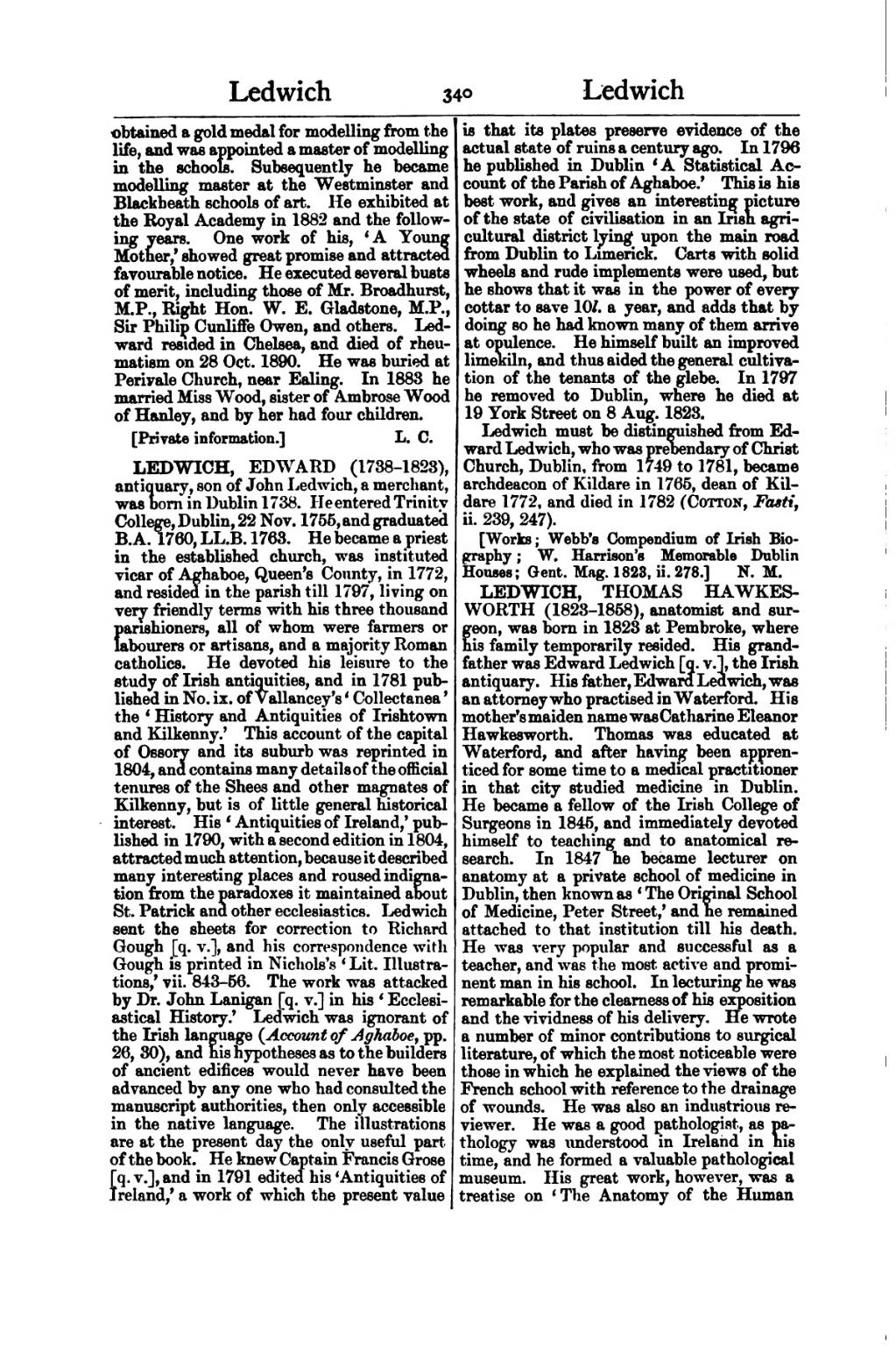obtained a gold medal for modelling from the life, and was appointed a master of modelling in the schools. Subsequently he became modelling master at the Westminster and Blackheath schools of art. He exhibited at the Royal Academy in 1882 and the following years. One work of his, 'A Young Mother,' showed great promise and attracted favourable notice. He executed several busts of merit, including those of Mr. Broadhurst, M.P., Right Hon. W. E. Gladstone, M.P., Sir Philip Cunliffe Owen, and others. Ledward resided in Chelsea, and died of rheumatism on 28 Oct. 1890. He was buried at Periyale Church, near Ealing. In 1883 he married Miss Wood, sister of Ambrose Wood of Hanley, and by her had four children.
[Private information.]
LEDWICH, EDWARD (1738–1823), antiquary, son of John Ledwich, a merchant, was born in Dublin 1738. He entered Trinity College, Dublin, 22 Nov. 1755, and graduated B. A. 1760, LL.B. 1763. He became a priest in the established church, was instituted vicar of Aghaboe, Queen's County, in 1772, and resided in the parish till 1797, living on very friendly terms with his three thousand parishioners, all of whom were farmers or labourers or artisans, and a majority Roman catholics. He devoted his leisure to the study of Irish antiquities, and in 1781 published in No. ix. of Vallancey's 'Collectanea' the ' History and Antiquities of Irishtown and Kilkenny.' This account of the capital of Ossory and its suburb was reprinted in 1804, and contains many details of the official tenures of the Shees and other magnates of Kilkenny, but is of little general historical interest. His 'Antiquities of Ireland,' published in 1790, with a second edition in 1804, attracted much attention, because it described many interesting places and roused indignation from the paradoxes it maintained about St. Patrick and other ecclesiastics. Ledwich sent the sheets for correction to Richard Gough [q. v.], and his correspondence with Gough is printed in Nichols's 'Lit. Illustrations,' vii. 843-56. The work was attacked by Dr. John Lanigan [q. v.] in his ' Ecclesiastical History.' Ledwich was ignorant of the Irish language {Account of Aghaboe, pp. 26, 30), and his hypotheses as to the builders of ancient edifices would never have been advanced by any one who had consulted the manuscript authorities, then only accessible in the native language. The illustrations are at the present day the only useful part of the book. He knew Captain Francis Grose [q. v.], and in 1791 edited his 'Antiquities of Ireland,' a work of which the present value is that its plates preserve evidence of the actual state of ruins a century ago. In 1796 he published in Dublin 'A Statistical Account of the Parish of Aghaboe.' This is his best work, and gives an interesting picture of the state of civilisation in an Irish agricultural district lving upon the main road from Dublin to Limerick. Carts with solid wheels and rude implements were used, but he shows that it was in the power of every cottar to save 10l. a year, and adds that by doing so he had known many of them arrive at opulence. He himself built an improved limelkiln, and thus aided the general cultivation of the tenants of the glebe. In 1797 he removed to Dublin, where he died at 19 York Street on 8 Aug. 1823.
Ledwich must be distinguished from Edward Ledwich, who was preoendary of Christ Church, Dublin, from 1749 to 1781, became archdeacon of Kildare in 1765, dean of Kildare 1772, and died in 1782 (Cotton, Fasti, ii. 239, 247).
[Works; Webb's Compendium of Irish Biography; W. Harrison's Memorable Dublin Houses; Gent. Mag. 1823, ii. 278.]
LEDWICH, THOMAS HAWKESWORTH (1823–1858), anatomist and surgeon, was born in 1823 at Pembroke, where his family temporarily resided. His grandfather was Edward Ledwich [q. v.], the Irish antiquary. His father, Edward Ledwich, was an attorney who practised in Waterford. His mother's maiden name was Catharine Eleanor Hawkesworth. Thomas was educated at Waterford, and after having been apprenticed for some time to a medical practitioner in that city studied medicine in Dublin. He became a fellow of the Irish College of Surgeons in 1845, and immediately devoted himself to teaching and to anatomical research. In 1847 he became lecturer on anatomy at a private school of medicine in Dublin, then known as 'The Original School of Medicine, Peter Street.' and he remained attached to that institution till his death. He was very popular and successful as a teacher, and was the most active and prominent man in his school. In lecturing he was remarkable for the clearness of his exposition and the vividness of his delivery. He wrote a number of minor contributions to surgical literature, of which the most noticeable were those in which he explained the views of the French school with reference to the drainage of wounds. He was also an industrious reviewer. He was a good pathologist, as pathology was understood in Ireland in his time, and he formed a valuable pathological museum. His great work, however, was a treatise on 'The Anatomy of the Human
